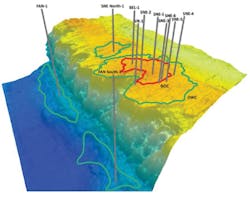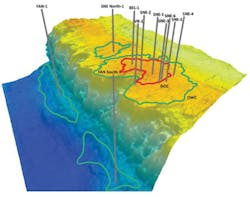TGS begins multi-beam survey offshore southern Brazil
TGS has started multi-beam acquisition for the Brazil Southern Basins SeaSeep project in the Campos and Santos basins offshore Brazil. This will cover the company’s existing surveys in the hydrocarbon-rich basins and the prospective presalt trend which contains many untested structures.
The 200,000-sq km (77,220-sq mi) coverage will be used to identify 330 target locations. Coring and geochemistry will follow, with data due to be made available in 4Q 2018 over the Round 16 licensing areas scheduled for next year. TGS expects to issue final results for all areas in late 2019.
The industry-supported survey is designed to mirror the company’s Gigante and Otos multi-beam and seep study projects in the Gulf of Mexico, conducted in 2016 and 2017.
Ireland grants extension for deepwater Newgrange well preparations
Providence Resources and Sosina Exploration have secured an extension to the first phase of frontier exploration license (FEL) 6/14, 260 km (161 mi) offshore southwest Ireland. The license, in 1,000 m (3,281 ft) water depth, contains the Newgrange prospect.
Ireland’s Minister of State for Communications, Climate Action & Environment granted an extension until end-March 2019. This will allow the partners to acquire a new high-resolution 2D seismic survey over the crest of Newgrange (subject to regulatory consent) and compile data for an application for permitting of an offshore exploration well. Discussions continue on a potential farm-out of equity in the license and with other nearby operators on potential synergies for an area-wide drilling program.
Dr. John O’Sullivan, technical director of Providence, said: “As the Newgrange well duration is expected to be extremely short, given that the primary Cretaceous reservoir target is just 500 m (1,640 ft) below the seabed, we are talking to other operators regarding potential rig-share opportunities.”
Atlantic Guardian concludes Barents Sea assignment
TheAtlantic Guardian vessel should have completed a multi-client seismic acquisition survey in the Norwegian Barents Sea last month, according to EMGS. Work started in early March, after the vessel had conducted a sea trial of the company’s DeepBlue equipment.
Another vessel, theBOA Thalassa, acquired data for the company on pre-funded multi-client surveys offshore Indonesia earlier this year, before returning to Malaysia.
Spectrum commences 2D multi-client survey over the Pernambuco-Paraiba basins
Spectrum has started a 6,000-km (3,728-mi) 2D program over the lightly explored Pernambuco-Paraiba basins along the Eastern Margins of Brazil. The survey covers an area north of the Sergipe basin, which will be included in Round 16 scheduled for 2019.
The survey is being acquired with a 12,000-m cable to record data necessary to understand basin architecture as well as to image prospective zones similar to the large oil discoveries in the Sergipe basin. Data will be processed in Spectrum’s Houston processing center with final PSTM and PSDM Broadband products available in 4Q 2018. This survey will be carried out in partnership with BGP Marine.
Richie Miller, EVP Multi-Client Americas, said: “This survey is the next step in producing a continuous modern long-offset survey covering all of the offshore areas of Brazil. The industry has a need for modern seismic data in this region, especially when the area will be included in Round 16. The Sergipe basin area to the south of Pernambuco has seen strong interest in the past three rounds and we expect the same for this area in Round 16, scheduled in 2019.”
FAR updates resources at FAN discovery offshore Senegal
FAR has reviewed the contingent resources attributed to the deepwater FAN discovery and the prospective hydrocarbon resources in its Rufisque, Sangomar, and Sangomar Deep permits offshore Senegal. These include the SNE oil field, discovered in 2014. The same campaign brought a discovery via the FAN-1 well.
Location of wells drilled to date in FAR’s offshore Senegal permits. (Courtesy FAR)
RISC Operations has completed an independent resources report for the FAN discovery based on well log interpretation and mapping using 3D seismic. The resource range is 30 MMbbl at the low (IC) end to 637 MMbbl at the high (3C) end.
Development is contingent on positive results from further appraisal. The discovery is roughly 20 km (12.4 mi) from the planned SNE development hub. FAR estimates SNE’s reserves at 641 MMbbl.
Last year, the partnership also achieved two new discoveries, FAN South and SNE North, and has made submissions to Senegal’s government of to undertake appraisal in order to better understand the commercial potential of tiebacks to the SNE field complex.
Parkmead considers stimulation for GPA
Parkmead has commissioned AGR Tracs International to conduct a reservoir study concerning well stimulation for the Greater Perth Area (GPA) field development in the UK central North Sea. Fracture stimulation could increase oil flow rates and oil reserves recovery from the Perth and Dolphin fields, Parkmead believes. The company has discussed a tieback of the GPA production to the Nexen-operated Scott complex.
Perth has in-place oil volumes of 197 MMbbl for the core part of the field, and 498 MMbbl when the northern areas are included. The reservoir has a gross oil column of around 610 m (2,000 ft), making it ideal for fracture stimulation, Parkmead claims.
Both fields are in the Moray Firth area, close to large producing oil fields such as Piper, Claymore and Tartan, and are Upper Jurassic Claymore sandstone accumulations that have tested 32-38° API oil at production rates of up to 6,000 boe/d per well.
At Perth, the sandstone forms a combined structural-stratigraphic trap, onlapping the Tartan Ridge to the north, with a southward-thickening and dipping sandstone wedge. The sandstones that comprise the accumulation were deposited as deepwater turbidites sourced from the Halibut Horst, with a minor contribution from the Tartan Ridge.






